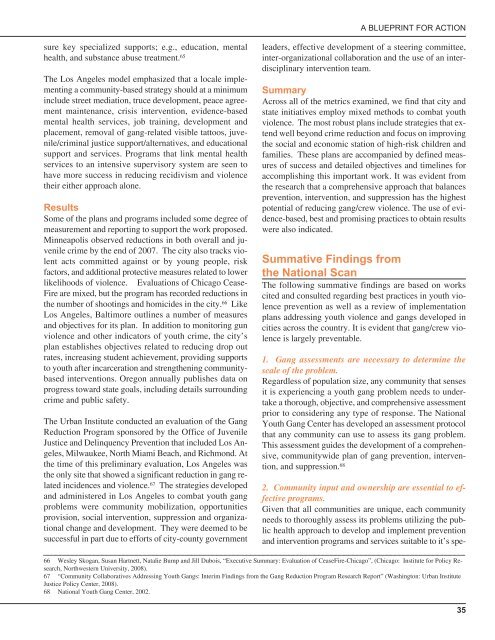Responding to Gang, Crew and Youth Violence in the District of Columbia
Responding to Gang, Crew and Youth Violence in the District of Columbia
Responding to Gang, Crew and Youth Violence in the District of Columbia
Create successful ePaper yourself
Turn your PDF publications into a flip-book with our unique Google optimized e-Paper software.
A BLUEPRINT FOR ACTIONsure key specialized supports; e.g., education, mentalhealth, <strong>and</strong> substance abuse treatment. 65The Los Angeles model emphasized that a locale implement<strong>in</strong>ga community-based strategy should at a m<strong>in</strong>imum<strong>in</strong>clude street mediation, truce development, peace agreementma<strong>in</strong>tenance, crisis <strong>in</strong>tervention, evidence-basedmental health services, job tra<strong>in</strong><strong>in</strong>g, development <strong>and</strong>placement, removal <strong>of</strong> gang-related visible tat<strong>to</strong>os, juvenile/crim<strong>in</strong>aljustice support/alternatives, <strong>and</strong> educationalsupport <strong>and</strong> services. Programs that l<strong>in</strong>k mental healthservices <strong>to</strong> an <strong>in</strong>tensive supervisory system are seen <strong>to</strong>have more success <strong>in</strong> reduc<strong>in</strong>g recidivism <strong>and</strong> violence<strong>the</strong>ir ei<strong>the</strong>r approach alone.ResultsSome <strong>of</strong> <strong>the</strong> plans <strong>and</strong> programs <strong>in</strong>cluded some degree <strong>of</strong>measurement <strong>and</strong> report<strong>in</strong>g <strong>to</strong> support <strong>the</strong> work proposed.M<strong>in</strong>neapolis observed reductions <strong>in</strong> both overall <strong>and</strong> juvenilecrime by <strong>the</strong> end <strong>of</strong> 2007. The city also tracks violentacts committed aga<strong>in</strong>st or by young people, riskfac<strong>to</strong>rs, <strong>and</strong> additional protective measures related <strong>to</strong> lowerlikelihoods <strong>of</strong> violence. Evaluations <strong>of</strong> Chicago Cease-Fire are mixed, but <strong>the</strong> program has recorded reductions <strong>in</strong><strong>the</strong> number <strong>of</strong> shoot<strong>in</strong>gs <strong>and</strong> homicides <strong>in</strong> <strong>the</strong> city. 66 LikeLos Angeles, Baltimore outl<strong>in</strong>es a number <strong>of</strong> measures<strong>and</strong> objectives for its plan. In addition <strong>to</strong> moni<strong>to</strong>r<strong>in</strong>g gunviolence <strong>and</strong> o<strong>the</strong>r <strong>in</strong>dica<strong>to</strong>rs <strong>of</strong> youth crime, <strong>the</strong> city’splan establishes objectives related <strong>to</strong> reduc<strong>in</strong>g drop outrates, <strong>in</strong>creas<strong>in</strong>g student achievement, provid<strong>in</strong>g supports<strong>to</strong> youth after <strong>in</strong>carceration <strong>and</strong> streng<strong>the</strong>n<strong>in</strong>g communitybased<strong>in</strong>terventions. Oregon annually publishes data onprogress <strong>to</strong>ward state goals, <strong>in</strong>clud<strong>in</strong>g details surround<strong>in</strong>gcrime <strong>and</strong> public safety.The Urban Institute conducted an evaluation <strong>of</strong> <strong>the</strong> <strong>Gang</strong>Reduction Program sponsored by <strong>the</strong> Office <strong>of</strong> JuvenileJustice <strong>and</strong> Del<strong>in</strong>quency Prevention that <strong>in</strong>cluded Los Angeles,Milwaukee, North Miami Beach, <strong>and</strong> Richmond. At<strong>the</strong> time <strong>of</strong> this prelim<strong>in</strong>ary evaluation, Los Angeles was<strong>the</strong> only site that showed a significant reduction <strong>in</strong> gang related<strong>in</strong>cidences <strong>and</strong> violence. 67 The strategies developed<strong>and</strong> adm<strong>in</strong>istered <strong>in</strong> Los Angeles <strong>to</strong> combat youth gangproblems were community mobilization, opportunitiesprovision, social <strong>in</strong>tervention, suppression <strong>and</strong> organizationalchange <strong>and</strong> development. They were deemed <strong>to</strong> besuccessful <strong>in</strong> part due <strong>to</strong> efforts <strong>of</strong> city-county governmentleaders, effective development <strong>of</strong> a steer<strong>in</strong>g committee,<strong>in</strong>ter-organizational collaboration <strong>and</strong> <strong>the</strong> use <strong>of</strong> an <strong>in</strong>terdiscipl<strong>in</strong>ary<strong>in</strong>tervention team.SummaryAcross all <strong>of</strong> <strong>the</strong> metrics exam<strong>in</strong>ed, we f<strong>in</strong>d that city <strong>and</strong>state <strong>in</strong>itiatives employ mixed methods <strong>to</strong> combat youthviolence. The most robust plans <strong>in</strong>clude strategies that extendwell beyond crime reduction <strong>and</strong> focus on improv<strong>in</strong>g<strong>the</strong> social <strong>and</strong> economic station <strong>of</strong> high-risk children <strong>and</strong>families. These plans are accompanied by def<strong>in</strong>ed measures<strong>of</strong> success <strong>and</strong> detailed objectives <strong>and</strong> timel<strong>in</strong>es foraccomplish<strong>in</strong>g this important work. It was evident from<strong>the</strong> research that a comprehensive approach that balancesprevention, <strong>in</strong>tervention, <strong>and</strong> suppression has <strong>the</strong> highestpotential <strong>of</strong> reduc<strong>in</strong>g gang/crew violence. The use <strong>of</strong> evidence-based,best <strong>and</strong> promis<strong>in</strong>g practices <strong>to</strong> obta<strong>in</strong> resultswere also <strong>in</strong>dicated.Summative F<strong>in</strong>d<strong>in</strong>gs from<strong>the</strong> National ScanThe follow<strong>in</strong>g summative f<strong>in</strong>d<strong>in</strong>gs are based on workscited <strong>and</strong> consulted regard<strong>in</strong>g best practices <strong>in</strong> youth violenceprevention as well as a review <strong>of</strong> implementationplans address<strong>in</strong>g youth violence <strong>and</strong> gangs developed <strong>in</strong>cities across <strong>the</strong> country. It is evident that gang/crew violenceis largely preventable.1. <strong>Gang</strong> assessments are necessary <strong>to</strong> determ<strong>in</strong>e <strong>the</strong>scale <strong>of</strong> <strong>the</strong> problem.Regardless <strong>of</strong> population size, any community that sensesit is experienc<strong>in</strong>g a youth gang problem needs <strong>to</strong> undertakea thorough, objective, <strong>and</strong> comprehensive assessmentprior <strong>to</strong> consider<strong>in</strong>g any type <strong>of</strong> response. The National<strong>Youth</strong> <strong>Gang</strong> Center has developed an assessment pro<strong>to</strong>colthat any community can use <strong>to</strong> assess its gang problem.This assessment guides <strong>the</strong> development <strong>of</strong> a comprehensive,communitywide plan <strong>of</strong> gang prevention, <strong>in</strong>tervention,<strong>and</strong> suppression. 682. Community <strong>in</strong>put <strong>and</strong> ownership are essential <strong>to</strong> effectiveprograms.Given that all communities are unique, each communityneeds <strong>to</strong> thoroughly assess its problems utiliz<strong>in</strong>g <strong>the</strong> publichealth approach <strong>to</strong> develop <strong>and</strong> implement prevention<strong>and</strong> <strong>in</strong>tervention programs <strong>and</strong> services suitable <strong>to</strong> it’s spe-66 Wesley Skogan, Susan Hartnett, Natalie Bump <strong>and</strong> Jill Dubois, “Executive Summary: Evaluation <strong>of</strong> CeaseFire-Chicago”, (Chicago: Institute for Policy Research,Northwestern University, 2008).67 “Community Collaboratives Address<strong>in</strong>g <strong>Youth</strong> <strong>Gang</strong>s: Interim F<strong>in</strong>d<strong>in</strong>gs from <strong>the</strong> <strong>Gang</strong> Reduction Program Research Report” (Wash<strong>in</strong>g<strong>to</strong>n: Urban InstituteJustice Policy Center, 2008).68 National <strong>Youth</strong> <strong>Gang</strong> Center, 2002.35


